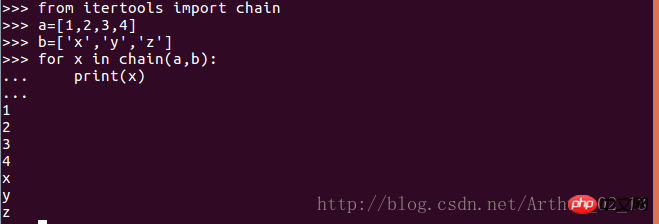
This article mainly introduces the relevant information on detailed examples of iterators and generators in Python. Friends in need can refer to
Python Detailed explanation of iterators and generator examples in Python
This article summarizes some related knowledge of iterators and generators in Python by focusing on different application scenarios and their solutions, as follows:
1. Manually traverse the iterator
Application scenario: I want to traverse all the elements in an iterableobject, but I don’t want to use a for loop
Solution: Use next()function, and catch the StopIteration exception
def manual_iter():
with open('/etc/passwd') as f:
try:
while True:
line=next(f)
if line is None:
break
print(line,end='')
except StopIteration:
pass#test case items=[1,2,3] it=iter(items) next(it) next(it) next(it)
2. Agent iteration
Application scenario: Want to perform an iterative operation directly on a container object containing a list, tuple or other iterable object
Solution: Define an iter() method to perform the iterative operation Proxy to the object inside the container
Example:
class Node:
def init(self,value):
self._value=value
self._children=[]
def repr(self):
return 'Node({!r})'.fromat(self._value)
def add_child(self,node):
self._children.append(node)
def iter(self):
#将迭代请求传递给内部的_children属性
return iter(self._children)#test case if name='main': root=Node(0) child1=Node(1) child2=Nide(2) root.add_child(child1) root.add_child(child2) for ch in root: print(ch)
3. Reverse iteration
Application scenario: Want to iterate a sequence in reverse
Solution: Use the built-in reversed() function or implement reversed() on a custom class
Example 1
a=[1,2,3,4]
for x in reversed(a):
print(x) #4 3 2 1
f=open('somefile')
for line in reversed(list(f)):
print(line,end='')
#test case
for rr in reversed(Countdown(30)):
print(rr)
for rr in Countdown(30):
print(rr)Example 2
class Countdown:
def init(self,start):
self.start=start
#常规迭代
def iter(self):
n=self.start
while n > 0:
yield n
n -= 1
#反向迭代
def reversed(self):
n=1
while n <p style="text-align: left;"><strong>4. Selective iteration</strong></p><p style="text-align: left;">Application scenario: I want to traverse an iterable object, but I am not interested in some elements at the beginning of it and want to skip</p><p style="text-align: left;">Solution : Use itertools.dropwhile()</p><p style="text-align: left;">Example 1</p><pre class="brush:php;toolbar:false">with open('/etc/passwd') as f:
for line in f:
print(line,end='')Example 2
from itertools import dropwhile
with open('/etc/passwd') as f:
for line in dropwhile(lambda line:line.startwith('#'),f):
print(line,end='')5. Iterate multiple sequences simultaneously
Application scenario: Want to iterate multiple sequences at the same time and take an element from one sequence each time
Solution: Use the zip() function




6. Iteration of elements on different collections
Application scenario: Want to perform the same operation on multiple objects, but these objects are in different containers
Solution: Use the itertool.chain() function

7. Expand nested sequences
Application scenario: Want to expand a multi-level nested sequence into a single-level list
Solution: Use RecursionGenerator containing yield from statement
Example
from collections import Iterable def flatten(items,ignore_types=(str,bytes)): for x in items: if isinstance(x,Iterable) and not isinstance(x,ignore_types): yield from flatten(x) else: yield x
#test case items=[1,2,[3,4,[5,6],7],8] for x in flatten(items): print(x)
Thank you for reading, I hope it can help everyone, thank you for your support of this site!
The above is the detailed content of Detailed explanation of iterator and generator instance methods in Python. For more information, please follow other related articles on the PHP Chinese website!




